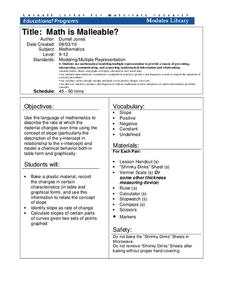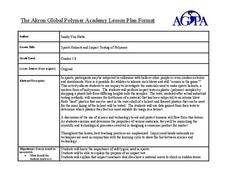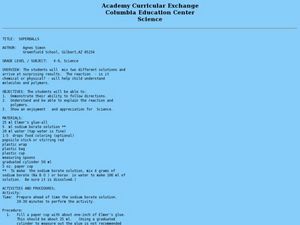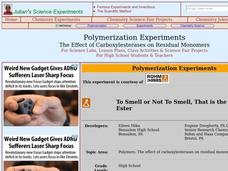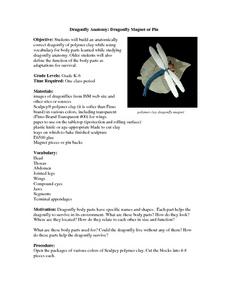Cornell University
Math Is Malleable?
Learn about polymers while playing with shrinky dinks. Young scholars create a shrinky dink design, bake it, and then record the area, volume, and thickness over time. They model the data using a graph and highlight the key features of...
Teach Engineering
Fun Look at Material Science
Introduce materials science with a class demonstration. After showing a PowerPoint presentation on materials and their properties, instructors provide a ceramic tile, a Popsicle stick, a paper clip, and a plastic bag as examples of...
Curated OER
Sports Helmets and Impact Testing of Polymers
Learners examine the importance of good quality safety gear. In this investigative lesson, students will tests various polymers, collect data, and analyze the data to determine which polymer is best for safety helmets. They will design a...
Curated OER
Activity: Polymer Clay Millefiori Cane Beads
Young scholars show an understanding of how millefiori beads are constructed by making some in several styles in polymer clay. They view images and techniques on a website imbedded in this plan and then attempt to make their own.
Curated OER
Polystyrene Containers
Students conduct experiments to determine the effectiveness of polystyrene containers at preventing heat loss. In this polymers instructional activity, students design an experiment to determine how effective Styrofoam burger containers...
Curated OER
Mystery Polymers
Students examine how some natural substances are polymers. In this polymer lesson students complete a lab and give examples of a physical change.
Curated OER
Slime and Intermolecular Attractions
Learners explore the strength of intermolecular attractions. They make slime and compare the difference in the physical properties of sheet and powdered polyvinyl alcohol with polyvinyl acetate.
Curated OER
How Shocking
Learners describe the characteristics of polymers and rubbers and how they improve human lives. In this shock activity students build a shock absorbing structure using different polymer materials.
Curated OER
Bouncing Balls
Students create a polymer ball in the lab. In this chemistry lesson plan, students identify the different properties of the polymer they created. They explain what type of chemical reaction took place.
Curated OER
Superballs
Young scholars mix two different solutions to become more familiar with molecules and polymers. In this chemistry lesson, students decide whether or not the reaction between two solutions is chemical or physical. Young scholars then...
Curated OER
Are Polymers Photodegradable?
Students study the term photodegradability and how it applies to the 6-pack loop ring. For this materials lesson students test photodegradability of the 6-pack plastic ring.
Curated OER
Oobleck, Goop, and Glurch
Sixth graders use teacher prepared samples of substances. They perform the same observations and complete charts for each substance. After recording and analyzing their results, 6th graders make changes in the recipes to create a better...
Curated OER
Make Slime
Students make slime. In this chemical reaction lesson, student use Borax to make a gel like solution. Students add all ingredients listed, add food coloring, and mix well. Students see first hand how chemicals react together and...
Curated OER
Bouncing Balls
Students create a polymer to demonstrate its properties and develop an awareness of the wide variety of uses for polymers.
Curated OER
Goofy Putty
Students examine mixtures and solution properties by making a borax polymer. In this chemical reactions lesson, students make a putty out of borax solution mixed to create a polymer.
Curated OER
Critter? Growth
Learners identify and use the elements of the scientific inquiry to solve problems. They explain concepts about the structure and properties of matter. Pupils write an explanation of polymers and how the characteristic of polymers...
Curated OER
Through Thick or Thin!!!
Students differentiate between high and low viscosity. Students collect, graph, and interpret data, then quantitatively measure polymer solids. Students experiment with a household example of an emulsion polymer.
Curated OER
Building Polymer Cup Speakers
Students investigate sound waves and they build audio speakers. In this audio speakers and sound lesson, students explore how to make quality audio speakers. As a team they build their own speakers to have clarity in sound, quality in...
Curated OER
Impress Yourself: Textured Pendants
Students experiment with textures and polymer clay while creating individual pendants. This lesson is suitable for all ages and includes ideas for adding "personal touches" to each pendant, baking the pendants, and applying texture and...
Curated OER
The Miracle Fish: Learning to Design an Experiment
Students develop procedures to explore the behavior of fish. In this scientific experiment lesson students from a hypothesis, write a question, identify different variables and controls in their experiment.
Curated OER
Polymerization Experiments
Students explain the process of polymerization. In this chemistry instructional activity, students produce carboxylesterase in the lab. They test its effectiveness in removing the by-product odor.
Curated OER
The Akron Global Polymer Academy Lesson Plan Format
Students identify types of garbage that will decompose quickly and the ones that do not. In this decomposing lesson students observe and record the photo degrading of six pack rings.
Teach Engineering
The Great Pacific Garbage Patch
The Great Pacific Garbage Patch is one of several garbage patches around the world where garbage accumulates naturally. As part of a GIS unit that combines oceanography, environmental science, and life science, class members investigate...
Curated OER
Dragonfly Anatomy: Dragonfly Magnet or Pin
Students build anatomically correct dragonflies of polymer clay, use vocabulary for body parts, and define the function of the body parts as adaptations for survival.


